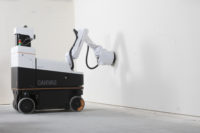Drywall Processes with Rick Eisfeller

We asked Eisfeller, the “mad scientist, drywall Macgyver,” an engineer-turned-drywaller, to weigh in on the best ways to improve the drywall process — working smarter, not harder — and he delivered. Here are his tips for how to streamline the jobsite, improve ergonomics, and choose tools to work more safely and efficiently.
Safety and Technique
Some of the simplest ways to improve jobsite safety, according to Eisfeller, are very simple. “Always wear a mask, no matter what you’re doing. Always have a pair of safety glasses on. No matter what,” he emphasizes, saying, “even from someone else’s work, something can come flying out.” He points out, too, that while these basics make a huge difference, they often get overlooked.
The other thing Eisfeller recommends is to limit the height of your stilts. “If you fall from that kind of height, hurt your arm that’s it… It only takes one little slip and you’re done.” He points out the trade-off that most people make, trying to exchange their safety for a faster job time, saying “people are walking around on super high stilts, thinking they’re saving time and money… I’d rather take my time and do a safe job.”
Besides, says Eisfeller, people unknowingly waste a lot of time by not thinking through their process. Better to make up the time with a more efficient workflow and avoid the stilts in favor of tools on a pole.
When it comes to technique, “most people don’t know time studies or process flow. You gotta take it to the next level: how long it takes you to do your nails, your butts, your seams, your corners. Some things should be done first, even if it doesn’t seem like it, [if you want] to get the best timeline. The biggest mistake is to just do what you normally do without asking if there might be a better way.”
As an example, he says, “a lot of people will do one wall at a time or one room at a time, but… if you do all your nails first, by the end of the day you can come back and do a second coat on your nails instead of waiting until tomorrow. Or by using buttboard, you’re using less mud, which means it dries faster. That makes the job quicker and it saves money on mud.”
Ergonomics and Efficiency
When it comes to ergonomics, most laborers are limited by the tools available to them. As a result, some of Eisfeller’s fixes for jobsite challenges are totally new tools or modified versions of tools, but you can accomplish a lot with some simple adjustments to your workflow too. Eisfeller’s top recommendations for improving efficiency and minimizing fatigue are pretty straightforward:
- Use auto tools when you can: simply put, the less you have to carry, the less strain you put yourself through
- Flushers for doing corners: “you’re taking away a lot of the hand movements,” which saves time, Eisfeller explains, “and you’re not bending over so much — saves a lot of back issues.”
- Auto sander with a vacuum: “these are huge for ergonomics. The vacuum sander is heavier, but [in the long run] it’s easier on your body.”
- Have the right tool for the job: “Some people use a pan and some use a hawk, but I believe every tool has a use. I don’t limit myself to ‘one or the other.’ Use the tool that’s best for the task.”
Takeaway
Eisfeller offers a wealth of advice on taking care of your most valuable tool — your body – while delivering an excellent product. Ask him one question about a particular tool, and he begins to unravel his considerable knowledge with a childlike enthusiasm that renders it as engaging as it is educational. And perhaps that is the biggest lesson we can all learn from this self-described “six-sigma drywaller”: stay curious. Never stop looking for ways you could improve your process or your tools.
“Not all jobs are the same — some are big, some are small and so on — so your process shouldn’t be the same. Most people do it the same way no matter what, but you have to adapt to the job. There’s got to be a way to improve what you’re doing,” Eisfeller advises.
To capture the “six-sigma” approach to efficiency and safety in a nutshell, it’s no surprise that Eisfeller says it best:
“You should learn something every day,” he says, “whether it’s good or bad.”
For those interested in seeing more of Rick’s gadgets and tools or in learning his approach, check out the Facebook Group “Fibafuse Users” which he runs as a sort of educational channel.
Looking for a reprint of this article?
From high-res PDFs to custom plaques, order your copy today!





